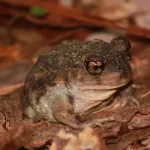(Press-News.org) CORVALLIS, Ore. - Research by a graduate student in Oregon State University's College of Science has upended the conventional wisdom that for a century has incorrectly guided the study of a toad listed as endangered in part of its range.
Anne Devan-Song used spotlighting - shining a light in a dark spot and looking for eye reflections - to find large numbers of the eastern spadefoot toad. The study illustrates how confirmation bias - a tendency to interpret new information as ratification of existing theories - can hamper discovery and the development of better ones.
Her findings, which show that the toad spends much more time above ground than commonly believed, were published in the Journal of Herpetology.
Known for bright yellow eyes with elliptical pupils and, as the name suggests, a spade on each hind foot, the eastern spadefoot toad ranges from the southeast corner of the United States up the Atlantic Coast to New England. Known scientifically as Scaphiopus holbrooki, it is a species of conservation concern in the northern reaches of its territory.
Devan-Song, a Ph.D. student in integrative biology, grew up in Singapore, where she learned she could search for reptiles and amphibians by spotlighting. In Rhode Island, where she earned a master's degree and then worked as a university research associate, the eastern spadefoot toad is endangered.
One rainless night while surveying for amphibians during a project in Virginia, Devan-Song's spotlight detected one eastern spadefoot after another. That surprised her because the toads were thought to be detectable only on a few rainy nights every year, when they emerge from underground burrows to mate in wetlands.
She continued looking for eastern spadefoots and kept finding them on dry nights, including in upland forest locales not close to any damp areas. Spadefoots remain still when spotlighted so it was easy for Devan-Song to approach the eye-shines and positively identify the toads.
"They need to get above ground to hunt for insects and build up energy stores for mating," she said. "That's why we were finding them when and where conventional wisdom said we weren't supposed to be finding them."
Back in Rhode Island, she tried spotlighting for spadefoots; it took her just 15 minutes to find one. The success led to a 10-night survey in a pair of locations last summer that produced 42 sightings - nearly double the number of eastern spadefoot toad sightings in Rhode Island over the previous seven decades.
Devan-Song also learned that she wasn't the first to question the notion that the eastern spadefoot was so "secretive" as to almost always avoid detection. As far back as 1944, Devan-Song said, it was suggested in scientific literature that the toad could be found outside of rain-induced migration and breeding aggregations. And in 1955, researchers used spotlighting to detect huge numbers of eastern spadefoots in Florida; the technique subsequently, inexplicably fell into disuse.
"Confirmation bias perpetuated the fallacy of when the eastern spadefoot could be found," Devan-Song said. "No breeding events or migration occurred during our surveys and we detected thousands of toads in Virginia and dozens in Rhode Island. The majority of those were subadults, a demographic category mainly overlooked in the literature. Progress in learning about the toad, its ecology and its conservation has been greatly hindered by a misconception that persisted even when evidence to the contrary was presented."
The ease with which many toads could be found during breeding, combined with a lack of data on toads in upland habitats, helped fuel confirmation bias in this case, she said.
"Everyone assumed they were underground most of the time so no one was really looking for them most of the time," Devan-Song said. "Our research demonstrates that you can detect them year round, though they do remain rare in Rhode Island. But likely not as rare as the scientific community thought."
INFORMATION:
The National Park Service, through a cooperative agreement with the University of Rhode Island, supported this research.
Chestnut Hill, Mass. (6/29/2021) -- A new, first-of-its-kind study led by researchers from Boston College has found that personal networks in India could play an important role in advancing the adoption of a cleaner cooking fuel, in this case liquefied petroleum gas, according to a report published in the journal Environmental Research Letters.
"This is the first report in clean cooking research to show that just like with tobacco use, obesity, or physical activity -- where our networks play a role in shaping our behaviors and decisions -- we find that personal networks are also associated with what kinds of stoves rural poor use.," said study co-author ...
The tiny mouse embryo has a heart that beats. Its muscles, blood vessels, gut and nervous system are beginning to develop. But this embryo is unusual: It was made in a lab, out of mouse embryonic stem cells, and represents the most sophisticated in vitro (in a dish) model of a mammal ever so created.
This new model, developed at the University of Virginia School of Medicine by Christine and Bernard Thisse, is a major step forward in scientists' efforts to mimic the natural development of a mammal by using stem cells. Its existence is a wonder that will help scientists understand mammalian development, battle diseases, create new drugs and, eventually, grow tissues and organs for people in need of transplants.
"We found a way to instruct aggregates of stem cells to initiate ...
Immunologists at McMaster University have discovered a previously unknown mechanism which acts like a spider web, trapping and killing pathogens such as influenza or SARS-CoV-2, the virus responsible for COVID-19.
The researchers have found that neutrophils, the most abundant white blood cells in the human body, explode when they bind to such pathogens coated in antibodies and release DNA outside of the cell, creating a sticky tangle which acts as a trap.
The findings, published online in the Proceedings of the National Academy of Science, are significant because little is understood about how antibodies neutralize viruses in the respiratory tract.
The discovery has ...
One of the key mutations seen in the 'Alpha variant' of SARS-CoV-2 - the deletion of two amino acids, H69/V70 - enables the virus to overcome chinks in its armour as it evolves, say an international team of scientists.
SARS-CoV-2 is a coronavirus, so named because spike proteins on its surface give it the appearance of a crown ('corona'). The spike proteins bind to ACE2, a protein receptor found on the surface of cells in our body. Both the spike protein and ACE2 are then cleaved, allowing genetic material from the virus to enter the host cell. The virus manipulates the host cell's machinery to allow the virus to replicate and spread.
As SARS-CoV-2 ...
A conclusive narrative review has found physical punishment of children is not effective in preventing child behavior problems or promoting positive outcomes and instead predicts increases in behavior problems and other poor outcomes over time. The study by an international group of scientists including a researcher from The University of Texas at Austin was published today in The Lancet.
Caregivers in many parts of the world use physical punishment as a response to children's perceived misbehavior: 63% of children between the ages of 2 and 4 worldwide - approximately 250 million children - are regularly subjected ...
Phase 1/2 clinical trial of CoronaVac in 550 children and adolescents aged 3-17 years in China suggests two doses of the vaccine are safe and generate a strong antibody response.
First published data on safety and immune response generated by a COVID-19 vaccine in children as young as 3-years-old supports use of CoronaVac - which was recently approved for emergency use in China among children over 3-years-old - in further studies to inform immunisation strategies.
Two doses of CoronaVac are safe and provoke a strong antibody response among children and adolescents ...
In first-of-its kind research led by a University of Massachusetts Amherst psychotherapy researcher, mental health care patients matched with therapists who had a strong track record of treating the patients' primary concerns had better results than patients who were not so matched.
In addition, this "match effect" was even more beneficial and pronounced for patients with more severe problems and for those who identified as racial or ethnic minorities.
The findings are published in JAMA Psychiatry and the Journal of Consulting and Clinical Psychology.
"One of the things we've been learning in our field ...
PULLMAN, Wash. - A research team led by Washington State University has created a computer model to understand how plants store energy in the thylakoid membrane, a key structure to photosynthesis in plant leaves.
The team confirmed the accuracy of the mathematical model with lab experiments. Their work was recently published in the journal Nature Plants.
"We provided an important piece to the overall puzzle of plant metabolism," said Helmut Kirchhoff, a professor in WSU's Institute of Biological Chemistry and leader of the team who made this discovery. "If we integrate our model into the bigger picture, it may provide a good path for how to improve plants for ...
Two recent collaborative publications by CU Cancer Center members provide insights into how chronic inflammation can serve as a key factor in the development of leukemia and other blood cancers.
Eric Pietras, PhD, CU Cancer Center member and assistant professor in the CU School of Medicine Division of Hematology, and James DeGregori, PhD, deputy director of the CU Cancer Center and professor in the Department of Biochemistry and Molecular Genetics, were corresponding authors on both papers.
Both papers provide support for the theory of adaptive oncogenesis, which was developed by DeGregori. The theory stipulates that chronic inflammation (such ...
AMES, Iowa - During the course of a criminal investigation, it is common for investigators to interview individuals who are exhausted and have had little sleep. While unavoidable in some cases, a new Iowa State University study found sleep disruption or deprivation may limit the amount of information provided during an interview.
The study, published in the academic journal SLEEP, is one of the first to look at how sleep affects behavior during interrogations or interviews. Zlatan Krizan, an ISU professor of psychology, says while beliefs about the impact of sleep on interrogation subjects have existed for decades, he and co-authors, ISU professor Christian Meissner and graduate student Anthony Miller, found little direct scientific evidence related to its effectiveness. Krizan ...





